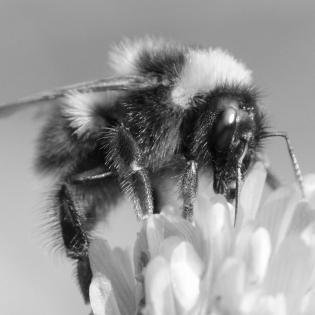Beneficial Bees - Elementary
Students learn about the role of bees as pollinators and learn about reasons their population numbers have been declining in recent years. They write a letter or create a handout to teach others how to help bees through planting native species.
The learner will:
- research the part bees play in the reproduction of plants through pollination.
- discover the importance of bees to our food supply.
- learn about why bees are struggling to thrive.
- student copies of Reproduction in Plants handout
- copy of the PowerPoint slide show to facilitate this lesson (below)
Use the attached PowerPoint to guide classroom discussion.
Students tell their families one fact they learned about bees and ask their families to help them research bees.
Students reread their own quick write from the Anticipatory Set. In small groups they discuss the following questions:
- How has your perception of bees changed?
- What did you learn about bees’ role in the reproduction of plants?
- How can your actions towards bees change others opinions?
- Amazon (2014). Bee & Me book by Elle J. McGuinness
- University of Illinois Extension (2017). Facts of the Case: Flower Parts. Retrieved from https://web.extension.illinois.edu/gpe/case4/c4facts1a.html
Instructions
Anticipatory Set: (5 minutes) Prompt prior knowledge and empathy to care about bees with the following Quick Write:
Display a picture of a bee on a flower. Tell students to take out a piece of paper and write for five to ten minutes about this picture. They may write about a memory that it brings, about how it makes them feel, make a list of words and emotions, or write about something they already know about the picture. Have them save the writing for later.
Share the fun video about bee communication: Phineas and Feb "Waggle Dance" https://www.youtube.com/watch?v=xe3LZBDcQvE
Read aloud the book “Bee and Me” by Elle J. McGuinness. There are YouTube versions available. On the last page are many facts about bees. Review the facts to build student appreciation and respect for bees.
Research the part bees play in the reproduction of plants through pollination by watch this three-minute video from Earth Rangers "Why do we need bees?" Discuss the facts and recap the threats to bees: disease, competition, habitat loss, pollution, pesticides, and climate change.
Go through the Great Plant Escape webpage from the University of Illinois Extension as a class to learn the parts of a plant and the process of pollination.
Discuss details of the video, readings, or book. Ask, “Why are bees important?” Talk about how life would be different if there were no bees around.
Discuss why bees are struggling to survive, and brainstorm as a class the types of plants with flowers that may attract bees and plants that use bees for pollination.
Help students recognize that their actions can make a difference. Connect the welfare of bees to students’ lives and the community. How can their action bring social change?
Service Project
Empower students to take action to help bees thrive in your community.Option 1: Students write a persuasive letter to their principal or parents asking for permission to plant bee-friendly plants.
- Students brainstorm reasons why someone would want to have bees around.
- Students look at their list of flowers and plants that attract bees and provide nutrition.
- Learn the parts of a persuasive letter.
- Students write their letter and peer edit with each other.
- Send the final copy to the person they wrote it to on Earth Day.
- Going Further: If you can find funds and get permission, plant a few species around your school.
Option 2: Students create art images that show their love for bees and label them with ideas for saving bees and the good bees do for us.
Option 3: Make a recipe that uses local honey. Talk about how they can encourage a love of bees with their families and friends.
Have a lily or other type of flower sitting at the front of the class with a magnifying glass beside it for students to examine as they turn in their assignment. It is beneficial for them to see the parts on an actual plant as well as on the computer.
Read about the service-learning project called Pollinator Garden by first grade students from Manchester Elementary School in Indiana who were taught using this Beneficial Bees lesson to guide student learning and action.
“I feel that the ultimate goal of teaching is to guide students to become good citizens and compassionate human beings,” said Ms. Fisk. “I care deeply about our world and the animals, so this was my way of getting my students thinking about their impact on the world.”
Philanthropy Framework
-
Strand PHIL.I Definitions of Philanthropy
-
Standard DP 01. Define Philanthropy
-
Benchmark E.1 Define philanthropy as the giving and sharing of time, talent, or treasure intended for the common good.
-
-
-
Strand PHIL.II Philanthropy and Civil Society
-
Standard PCS 03. Philanthropy and Economics
-
Benchmark E.5 Recognize the wise use of resources as <i>stewardship</i>.
-
Benchmark E.9 Identify the "commons" in the school and neighborhood.
-
-
Standard PCS 05. Philanthropy and Government
-
Benchmark E.9 Describe how philanthropic activities can bring about social change.
-
-
Standard PCS 07. Skills of Civic Engagement
-
Benchmark E.1 Explore and research issues and present solutions using communication tools.
-
-
